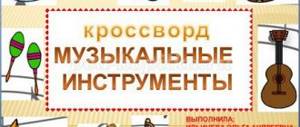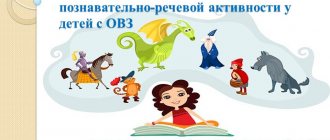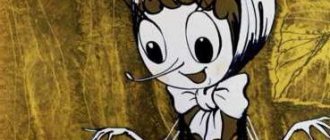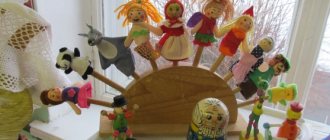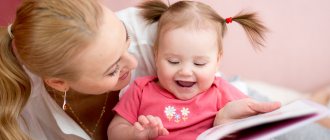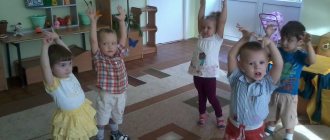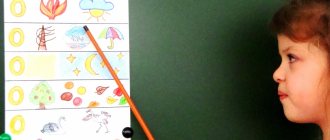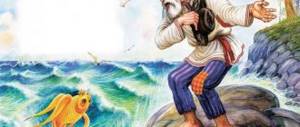Series of lessons “Speech therapy tales”
Children love fairy tales, children believe in fairy tales... And we invite you to immerse yourself in long-familiar fairy tales and use this rich material to develop the child’s abilities and capabilities.
Description of work
: This methodological development will be useful for educators, parents, speech therapists, defectologists and educational psychologists. The manual was developed with the aim of teaching effective interaction between preschool children in a group, using game material on fairy tale therapy.
annotation
Correctional and developmental activity is a complex pedagogical process, the result of which should be the normalization of all aspects of the child’s speech, the development of psychomotor skills, cognitive and mental processes, the education of the child’s personality, and also take into account the creation of a health-preserving environment. In the context of the implementation of the federal state educational standard for preschool education, the teacher is obliged to guarantee the protection and strengthening of the physical and mental health of children, as well as to ensure the emotional well-being of each child. Thus, improving the quality of children’s education is one of the important areas of modernization of preschool education.
Based on the requirements of the Federal State Educational Standard of the new generation, the teacher is faced with the question of improving the quality of preschool education for children through the use of modern technologies. One of these technologies is the use of elements of the method of complex fairy tale therapy.
Fairy tale therapy is a young, modern and promising direction in practical psychology and pedagogy, which, using the metaphorical resources of fairy tales, allows you to develop a child’s self-awareness, become himself and build special, trusting, close relationships with others. The fairy tale therapy method is a health-saving technology, a comprehensive system aimed at correcting speech disorders, the personal development of the child, preserving his health and allows, within the framework of a fairy tale, to solve correctional, educational, developmental and educational tasks. A fairy tale is the most accessible material for the development of a child’s mental activity. The world of a fairy tale is wonderful, it is unique and inimitable in its capabilities. Fairy tales are simple, cyclical in nature - repeated repetition of the plot with slight changes. This feature of folk tales allows the child to better remember the plot and develops memory. It is fairy tales that help to awaken interest in words.
“Fairy Tales” is perfect for kids who are just starting to participate in group activities - because here the action takes place around an already familiar plot. And older children will be interested in “playing a fairy tale” in a new way. Therefore, the presented material can be used in work with a wide age range - from 3 to 7 years.
The fairy tale sets out in detail the scheme of sequential actions. This is very important for a child, because in order to learn the connection between cause and effect, he needs to trace every step from the beginning of the path to its completion.
Children acquire knowledge through repeated repetition. At the same time, they do not like monotonous activities, from which they quickly get tired. The proposed material for complex lessons allows you to play a fairy tale, operating in all educational areas: artistic-aesthetic, physical, speech, social-communicative and cognitive. A fairy tale serves as the best material for a dramatization game. While playing, a child is able to understand and evaluate the actions of the heroes of a fairy tale, condemn the actions of negative characters, and evaluate his own actions and the actions of other people. In fairy tales, there are good and bad heroes - the child always wants to take on the role of a positive hero. The child is able to transfer the acquired knowledge into everyday life, this helps him regulate his behavior and establish relationships with peers and adults. The child begins to master the norms and rules of behavior, he develops ideas about what is good and what is bad. Each fairy tale included in the proposed complex contains material that allows organizing mini-trainings related to the safe behavior of children, which is currently a very pressing issue.
The language of the fairy tale is rhythmic, the words are rhymed, the characters are given definitions - this also allows the child to enrich the vocabulary and better remember and understand the content of the fairy tale. In the process of classes, speech develops, the vocabulary is enriched by nouns, adjectives, verbs, pronouns, adverbs, and numerals. Special attention is paid to practicing prepositions and skills in forming possessive and relative adjectives. Some of the tasks are devoted to the development of the prerequisites for the development of clear speech - training articulatory motor skills and speech exhalation. Exercises in intonation expressiveness and tempo-rhythmic organization of speech are not left aside.
With the development of speech, the child begins to develop thinking. The words are general in nature. In the process of playing with fairy tales, vocabulary on various topics is updated, tasks are performed to eliminate unnecessary things, select logical ones, and establish logical and cause-and-effect relationships.
Standards of color, shape and size of objects are fixed, and games are offered to develop tactile perception. Elementary mathematical concepts are formed. Children consolidate quantitative and ordinal counting skills, practice addition, dividing equally, and doubling objects. Spatial concepts develop.
Tasks on modeling fairy tales using geometric figures gradually lead away from concrete images to abstraction, i.e. prepare for mathematical activities with signs and numbers.
For older preschoolers, the tasks “New Fairy Tales” and “I Give Advice” are intended, offering unconventional use of fairy-tale material, creatively transforming the course of the story, inventing different endings, introducing unforeseen situations, etc. In the course of completing such tasks, children's thinking and imagination develop. It is imagination that makes life individually creative, unique, and non-standard.
For each type of activity, options and types of complications are proposed that will correspond to the capabilities of children in a particular group, so the teacher can choose tasks of such a level of complexity so that it is feasible, interesting and exciting for each child. The material of each summary is designed not for one, but for several lessons held during the day or week (at the choice of the teacher). It is important to organize the activity so that each stage of the game smoothly flows from one to another without delays and searches for the necessary attributes.
"Turnip"
Objectives: development of fine motor skills; development of articulatory motor skills; development of speech exhalation; development of spatial concepts; working with prepositions “before”, “behind”, “after”; exercise in carrying out multi-step instructions; working on the tempo of speech; work with sensory standards; enrichment, clarification and updating of the dictionary of quality adjectives development of imagination and fantasy
Equipment: table theater “Turnip”; matryoshka “Turnip”, screen didactic game “Turnip” with characters on Velcro; yellow circle, yellow ball, picture “Turnip” chalk or marker board, or paper and felt-tip pen audio recording of the fairy tale “Turnip” a set of various balls, bag, hoops
additionally: cards with the names of the heroes, Zaitsev, Chaplygin cubes, magnetic alphabet, chalk board, etc. Nikitin fractions
- Introduction to the topic
- Today a fairy tale will come to visit us. How do we call a fairy tale?
“Fairy tale, come!” They clap their hands. “Shhh...” The screen is removed - behind it lies a yellow circle
Today a fairy tale about a vegetable will come to visit us.
Hint figure: yellow circle
Riddle-hint : Yellow side, round side - the bun lies on the bed. Rooted firmly into the ground. What is this?
Hint picture: turnip
Hint toy :
turnip
- Remembering a fairy tale
“Talking turnip” Speech exhalation
- How beautiful our turnip is! Round, smooth, strong! And what green leaves it has! Listen to how the turnip rustles with its leaves.
Children take turns blowing on turnip leaves
It seems that the turnip wants to tell you something.
The fairy tale is told by a speech therapist together with the children or an audio recording is listened to
- Working on a fairy tale
“Oh, what a turnip!” Qualitative adjectives
- Say a lot about the turnip. What is she like?
Younger children with support from a picture (on the demo table there is a turnip from the theater) older children without visual support
The yellow ball is passed around in a circle (if there are many children), the speech therapist asks leading questions with older children - the “drawing” technique is used
(big, yellow, ripe, round, large, huge, sweet, strong, fabulous, smooth...)
- “Such different turnips!” Sensory standards. Story-description.
- Look how many different turnips there are!
(balls of various sizes, colors, textures and weights are poured onto the carpet)
— Find the biggest... The smallest
- Yellow... Red... Green... Blue... Multi-colored...
- Hard... Soft...
- Fluffy... Smooth... Rough
- Heavy... Light...
- Let's collect our harvest in a bag
- And now everyone will get one turnip for themselves and tell what it is like...
Children complete the task, the speech therapist suggests signs (color, shape, size, touch...)
- "Warm-up." Articulation gymnastics
— When my grandfather decided to plant a turnip, he began to dig up the garden. How? With a shovel. (“scapula”)
— Then he planted seeds in the ground (“football”)
- At first the turnip was small (suck in your cheeks)
- Then it grew big, very big (puff out cheeks, hold)
- Small - big - small - big... (alternation)
- When the grandfather could not pull out the turnip, he frowned (furrow his eyebrows)
“Then I started looking around, who should I call for help?” (“watch”)
“Grandfather and his whole family pulled the turnip out of the ground, and we will pull the tongue.” High, high, right up to your nose! (4-5 times)
— When they pulled the turnip out of the ground, everyone was happy and began to smile (“smile”)
— And then they ate the turnip and licked their lips (4-5 times)
- "Speech exercise." Rate of speech.
- Let's remember all the heroes of this fairy tale and the poem from it.
The characters are introduced one by one.
- Who can recite this poem quickly and quickly?
- And now very slowly, but without stopping.
- Now it's fast, then it's slow.
- "Queue". Prepositional constructions. Spatial representations
Here is a turnip and fairy tale characters for each of you. Put them in order.
- Tell me, who is first in line? last? third? fifth? second?
- Who is standing in front of the Bug? after grandma? for the cat? between a mouse and a bug?
- Now build a queue in which: - the first is the grandmother, the last is the cat, the granddaughter is the third; - the second is the granddaughter, in front of her is the Bug, the grandfather is the last, in front of him is the mouse; - the last one is Zhuchka, the second one is the grandmother, the fourth one is the grandfather, after the grandfather one is the granddaughter.
- Do you remember how the fairy tale began? ( Grandfather planted a turnip)
Grandfather did NOT plant the turnip... But who did?
(granddaughter, Baba Yaga, three bears...)
grandfather planted NOT a turnip... So what?
(carrot, birch, chamomile...)
- Choose names for the heroes of our fairy tales
(using table theater, masks, etc.)
"Kolobok"
Objectives: development of fine motor skills; development of articulatory motor skills; development of speech exhalation; voice modulations; work with sensory standards; enrichment, clarification and updating of the dictionary of quality adjectives; formation of mathematical ideas about parts and the whole development of logic, imagination and fantasy
Equipment: yellow circle; table theater "Kolobok"; screen book-poster “Kolobok”; yellow ball; pictures “white hare”, “gray hare”, “wolf”, “bear”, “fox”; samples of artificial fur in light gray, dark gray, brown and orange colors; “Obedient breeze”, tennis balls, “range” set of various balls, bag, hoops
additionally: cards with the names of the heroes, Zaitsev, Chaplygin cubes, magnetic alphabet, chalk board, etc. Nikitin fractions
I. _ Introduction to the topic
- Today a fairy tale will come to visit us. How do we call a fairy tale?
“Fairy tale, come!” They clap their hands. “Shhh...” The screen is removed - behind it lies a yellow circle
- The main character of the fairy tale that we will find ourselves in today also has a yellow circle. What kind of fairy tale is this?
The yellow circle is replaced by a kolobok figurine from the tabletop theater
II . Remembering a fairy tale
on the demo table, the teacher, with the help of figures from the theater and with the active support of the children, recites a fairy tale, the kolobok song is accompanied by the performance of gestures
finger gymnastics
| I am a bun, a bun, swept across the barn, scraped through the bottom ends, mixed with sour cream, planted in the stove, chilled at the window. I left my grandfather, I left my grandmother, I left the hare, I left the wolf, I left the bear, It’s not smart to leave you, fox. | clapping your hands right palm strokes the left left palm “scrapes” the right palms knead each other palms straighten back side down palms turn back side up right hand bends the thumb on the left hand right hand bends the index finger on the left hand right hand bends the middle finger on the left hand, the right hand bends the ring finger on the left hand, the right hand bends the little finger on the left hand, the fist unclenches with a waving movement |
III . Working on a fairy tale
- Logical warm-up.
- Do you think this story happened in winter or summer?
- Where did grandma put the bun to cool down? (on the window)
- And since the bun rolled away, did that mean the window was open or closed? (open)
- Do the windows open wide in winter? (No)
- Who did the bun meet on the way? (hare, wolf, bear, fox)
As they are named, the characters of the fairy tale are put on display. table
- Could a bun meet a bear in winter? (no, the bear sleeps in winter)
- Where is the path along which the bun rolled - in the forest or in the city? (In the woods)
- It turns out that this story happened in the summer, in the forest, and everyone the bun met were forest dwellers
- Who did the bun meet first on the way? (hare)
Fizminutka
The little gray bunny sits and wiggles his ears. It's cold for the bunny to sit, he needs to warm his little paws. It's cold for the bunny to stand, the bunny needs to jump
- Who did the bun meet after the hare? (wolf)
- What color is the wolf? Find the same card and take it to the wolf
- How many paws does a wolf have? Ears? Khvostov?
- When the bun rolled away from the wolf, he became upset and howled
Development of the voice and speech exhalation “The wolf howls”
- Who did the bun meet after the wolf? (bear)
- What color is the bear? Find the same card and take it to the bear
- How many ears does a bear have? Lap?
- What kind of tail does a bear have - long or short?
- Let's show how a bear walks.
- Do you know what the bear likes to eat? (honey)
Fizminutka
Our little bear stretched - he bent over once, he bent over twice. He spread his paws to the sides, apparently didn’t find any honey. He climbed a tree - and now he licks sweet honey from his paw!
- Who was the last person the kolobok met? (fox)
- What color is the fox? Find the same card in your place and take it to the fox.
- How many paws does a fox have? Ears? Khvostov?
- What kind of tail does a fox have?
- Why is the fox called a cheat in fairy tales?
- Who did the fox deceive in this fairy tale?
2. Vocabulary warm-up. (for children 5-7 years old)
- Let's remember what other characters are in the fairy tale "Kolobok"?
As they are named, the characters from the tabletop theater are displayed on the table.
- If I remove the main character, Kolobok, then those who remain can be divided into two groups. Which? (people and animals)
- Let's talk about each animal from the fairy tale. The poster book “Kolobok” is used - which hare? ( small, fluffy, cowardly, funny, grey...)
- what wolf?
(medium in size, gray, hungry, toothy...)
- what kind of bear?
(huge, brown, clumsy, club-footed...)
- what kind of fox?
(small, red-haired, beautiful, cunning...)
- They told about everyone, but forgot about the bun. What is he like? The bun rolls towards the children and wants to hear what they have to say about it!
The yellow bun ball is passed around in a circle (if there are a lot of children), the speech therapist asks leading questions (round, small, yellow, ruddy, tasty, fresh, fragrant, cheerful, brave, boastful...)
- "Saving the Kolobok"
- It’s a pity for such a wonderful bun! Let's save him from the fox!
Development of the voice and speech exhalation using the “Obedient Breeze” manual - blow the bun off the fox’s nose, tennis balls - whose will roll further
- “Such different koloboks!” Sensory standards. Story-description.
- Grandma baked many, many different koloboks! (different balls are poured onto the carpet)
— Find the biggest... The smallest
- Yellow... Red... Green... Blue... Multi-colored...
- Hard... Soft...
- Fluffy... Smooth... Rough
- Heavy... Light...
- Let's collect all the koloboks in a bag
- And now everyone will take out a kolobok and tell you what it is like...
Children complete the task, the speech therapist suggests signs (color, shape, size, touch...)
- Speech exercise
- What did the animals say when they met Kolobok in the forest? (Kolobok, Kolobok, I'll eat you!)
.
The game “Guess whose voice” uses characters from a tabletop theater and a screen, first the adult speaks in animal voices, then, in turn, the children themselves
- Articulation gymnastics “Kolobok”
“Across the barns broom” - movements of the tongue left and right along the lower lip
“Scratched the bottom of the barrel” -
pushing the tongue between the teeth
“kneaded the dough” -
“football”
“put it on the window to chill” -
open the mouth, the tongue lies calmly at the bottom of the oral cavity
“the bun got bored” -
“watch”
“jumped from the window” - “ horse" - "fungus" "rolled" - circular movements of the tongue "met a hare" - "swing": hare jumps or ears "met a wolf" - "pipe": a wolf howls in a whisper "met a bear" - energetic movements of the lower jaw "met a fox" "-"delicious jam", the fox licks his lips
- “How we divided the bun” (using the manual “Nikitin’s Fractions”)
Choose an option for treating grandma and grandpa. What if your granddaughter arrives? Divide into forest animals? Divide it so that all the children in the lesson can enjoy it?
- "I give advice."
- Let's go back to our Grandfather and Grandmother. How do you think they felt when they discovered that Kolobok was missing? (upset, upset, offended, depressed)
- What should Grandfather and Grandmother have done to prevent Kolobok from rolling away? (do not leave unattended, do not place on a window, do not open a window, bake in the form of a cube...)
- Now let's think about Kolobok. The fox turned out to be more cunning. What needs to be done to outsmart her? (not to believe her, to become stale and tasteless, to become green so that it is not noticeable in the grass...)
- Reading (older children only)
- Choose names for the heroes of our fairy tales
- Make up the names of the characters
- “New Fairy Tales” (for children 5-7 years old)
- Now listen: the tricky word NOT got into the fairy tale and this is what happened... Grandma did NOT bake a bun... And what did she do? (found, bought, made...)
It was NOT grandma who baked the bun... But who?
(granddaughter, Baba Yaga, three bears...)
the grandmother baked NOT a bun... What?
(cake, roll, pastry...) - Figure out what happened next
III . Fairy tale dramatization.
(with the addition of heroes from the previous tale.)
"Teremok"
Objectives: development of fine motor skills; development of articulatory motor skills; development of spatial concepts; concepts of “left”, “right”, “above”, “below”; work with prepositions “above”, “under”, “between”; exercise in carrying out multi-step instructions; enrichment, clarification and updating of the dictionary on the topic “tools”, “house”, improvement of mathematical skills of counting and addition, development of imagination and fantasy
Equipment: matryoshka doll “Teremok”, screen tabletop theaters “Teremok”, “Kolobok”, “Turnip”; scheme of the mansion; schematic images of a wolf, fox, frog, bear, hare, mouse. chalk or marker board, or paper and felt-tip pen audio recording of the fairy tale “Teremok” pictures of objects “Tools” wooden construction set illustration “hut”, “house”
additionally: cards with the names of the heroes, Zaitsev, Chaplygin cubes, magnetic alphabet, chalk board, etc.
I. _ Introduction to the topic
- What fairy tales have we already visited? (“Turnip”, “Kolobok”)
- Let's remember the heroes of these fairy tales. As they are named, the characters are placed on the demo table. (Grandfather, grandmother, granddaughter, dog, cat, mouse, bun, hare, wolf, bear, fox)
- Now name only those animals that can live in the forest. (hare, wolf, bear, fox, mouse)
Children name, the adult puts these characters in the first row, and removes the remaining ones.
- And now I’ll add one more character, and you’ll try to guess what fairy tale we’ll be playing with today.
A frog is added
- That's right, this is the fairy tale "Teremok"
II . Remembering a fairy tale.
Reading for adults. Audio recording.
III . Working on a fairy tale
- Warm up.
- What is a teremok? (Terem is a large beautiful house in the old days)
Show in picture
- Why do they say about a mouse “The mouse is a bitch”? (lives in a hole)
- What else can you call a mouse? (baby)
- Why is a frog called a frog? (croaks)
- What other nickname can you give her? (jump)
- “Jumping Bunny,” that’s what they call a hare in a fairy tale. Why? (jumps)
- What is another name for a hare in fairy tales? (bunny - coward)
- Why wasn't he called that in our fairy tale? (he is brave, lives in the same house with a fox and a wolf)
- The fox in this fairy tale is called “The fox is the beauty of the whole forest.” Why?
- What other nicknames does a fox have? (cheat, little fox-sister...)
- Did the fox deceive anyone in this fairy tale?
- The nickname of the wolf in the fairy tale “Teremok” is “The top is a gray barrel.” Why? (he has a gray side)
- What other nicknames does a wolf have? (wolf - clicking teeth)
- Why don't they say that about the wolf in this fairy tale? (he's not evil)
- What nickname will we give to the bear? Did he break the tower out of anger or accidentally?
2. Self-massage. Articulation gymnastics
- “Wall, wall, ceiling, doors, windows and bell” massage: stroking, tapping cheeks and forehead, close your eyes, open your eyes wide, raise your eyebrows, frown, open your mouth, wrinkle your nose
- “The mouse squeaked quietly and did not wake the cat” quiet tapping of lips
- “Frogs really like to pull their lips straight towards their ears. They smile, laugh, and their eyes are like saucers!” "smile"
- “Oooh! Woohoo! Wolves howl at the moon" "tube"
- “The gray wolf clicks his teeth. Until he bites, but grins angrily...” “grin”
- “The fluffy fox tail flashes, covering all traces” “watch”
- “Jump-jump, jump-jump, the bunny jumped onto the stump. He beats the drum loudly and invites all the guys to play!” "horse", "machine gun"
- “Teddy bear, too clumsy” “nut”
3. Speech exercise
- What did the animals say as they approached the tower? (Who-who lives in a little house? Who-who lives in a low one?)
.
The game “Guess whose voice” uses characters from a tabletop theater and a screen, first the adult speaks in animal voices, then, in turn, the children themselves
4. I give advice.
Fairy tale and mathematics
- The tower fell apart. What should the animals do? (build a new one)
- First you need to figure out what the tower will be like. How many rooms should it have so that there is enough for everyone?
- Our mansion will have three floors (diagram of the mansion) Show me where the first floor is? Where's the third one? Second?
- Who is better to accommodate on the first floor? Second? Third? Why? (focus on body weight, size of animals)
- Imagine that when it rains outside, each of the characters puts on rubber boots. How many boots will there be in the hallway of the tower? How many pairs? (for children 5-7 years old)
Spatial representations, prepositions
- Who lives above the bear? Over the fox? ...
- Who does the mouse live above? Wolf?
- Who lives under the bunny? Under the frog?
- Who lives above the fox? Below the hare?
- Who lives to the right of the fox? To the left of the wolf? Who lives between the mouse and the frog?
Expanding vocabulary “Tools”
- Where to get material for building a tower? (In the woods)
- How do we cut down a tree? (saw)
- How do we cut off the branches? (with an axe)
- How do we plan the logs? (with a plane)
- How do we fasten them together? (we hammer the nails in)
Development of fine motor skills
- Terem-terem-teremok, the animals were building a house... Who will build the tallest wall/tower?
Laying out a wall of beams or a tower of cubes. Children 5-7 years old building a house
Vocabulary “HOUSE” (work with illustration)
- Terem-terem-teremok, the animals were building a house Shutters
carved
,
painted
.
The house is growing higher and higher, there is
a cornice, a chimney
and
a roof.
5. “New fairy tales” (for children 5-7 years old)
- Do you remember how the fairy tale began? ( There is a tower in the field)
- Now listen: the tricky word NOT got into the fairy tale and this is what happened... There is a tower in the field NOT... And what?
- Figure out what happened next
6. Reading (for older children only)
- Choose names for the heroes of our fairy tales
- Make up the names of the characters
IV . Fairy tale dramatization.
(using table theater, masks, etc.)
Dramatization + “We have guests” (for 5-7 years)
Children act out the fairy tale first according to the traditional scheme, then the required (according to the number of children) number of characters from other fairy tales (gingerbread man, grandfather, cat, etc.) is added. The final stage is the appearance of the bear. Along the way, questions are asked: “What can the character do?” (reliance on visual image), “What fairy tale is he from?” (for guests)
"Three piglets"
Objectives: development of fine motor skills, tactile sensitivity, development of speech exhalation; development of spatial concepts; concepts “left”, “right”, “above”, “below” work with prepositions “above”, “under”, “between” improvement of mathematical skills (dividing equally) exercise in the formation of relative adjectives learning to model using geometric figures development of imagination and fantasies
Equipment: table theater “The Three Little Pigs”; decorations of trees, a screen, an audio recording of the fairy tale “The Three Little Pigs,” a dry finger pool (peas, beans, etc.) or sand, acorns (10-20 pieces), a set of geometric shapes for modeling the fairy tale, wrapping paper noodles, matches, sticks, decorative pebbles illustration “What kind of houses are there?” puzzle game “Where is whose house”
additionally: cards with the names of the heroes, Zaitsev, Chaplygin cubes, magnetic alphabet, chalk board, etc.
I. _ Introduction to the topic
- Today a fairy tale will come to visit us again. How do we call a fairy tale?
Children clap their hands and say: “Fairy tale, come!” "Shhhhh"
- The fairy tale we will play with today is called... Look at these figures and guess for yourself
Three pink circles
- That's right, this is the fairy tale "The Three Little Pigs"
II . Remembering a fairy tale.
Audio recording.
III . Working on a fairy tale
- Scenery
- Where do you think this story took place? (at the edge of the forest)
- So for our scene we need trees.
- What time of year do you think this story took place?
- So what color should the trees be? Choose the ones that suit you.
Autumn tree decorations are being installed
- What material did Nif-Nif decide to make a house from? (from straw)
- So the house he built is called ... (straw)
- Find Nif-Nif and his house.
- What material did you decide to make yourself a house from? Nuf-Nuf? (from tree branches)
- So, the house he built is called... (wooden)
- Find Nuf-Nuf and his house.
- What material did Naf-Naf decide to make a house from? (from stones)
- So the house he built is called... (stone)
- Find Naf-Naf and his house.
House decorations and piglets are being installed
- Fairy tale and mathematics
- What do piglets like to eat? (acorns)
- Find acorns in this trough.
Children search for acorns in a dry finger pool, then do math problems
- Help the piglets divide equally 6 acorns, 9 acorns, 12 acorns, 15 acorns, 18 acorns.
- Speech exercises. Intonation.
- What's happened careless
?
prudent
? - Which piglet is the most prudent? Who is the most careless? Why?
- Which piglet has the highest, thinnest voice? (At Nif-Nif)
- Which piglet has the deepest, deepest voice? (At Nuf-Nuf)
- Which piglet has an average voice? (At Naf-Naf)
- Let's sing a song about piglets in different voices.
“We are not afraid of the gray wolf, gray wolf, gray wolf! Where do you go, stupid wolf, old wolf, dire wolf?
2. Dramatization + modeling
Establish the relationship between geometric shapes and fairy tale characters and their houses.
The stages of the fairy tale are demonstrated sequentially using geometric figures, guessed by children and found confirmation behind the removed screen
If you have time, invite children to create a model of a particular situation on their own.
Stages: 1. the piglets are having fun, a wolf is watching them from afar. 2. piglets near the built houses, the wolf is close. 3. Nif-Nif hid in a straw house, the wolf was nearby. 4. The straw house is destroyed, Nif-Nif and Nuf-Nuf are in the house made of branches, the wolf is nearby. 5. The straw house and the house made of branches are destroyed, the piglets are in the stone house, the wolf is nearby. 6. the same, but the wolf is on the house. 7. The wolf runs away, the piglets dance around the house
3. Prepositions, spatial representations.
- Tell me where the wolf is now?
- Place the wolf behind the house, in front of the house, to the right of the house, between the houses, etc.
4. Speech exhalation.
- How did the wolf destroy the pigs' houses? ( blowed on them )
- Let us also test the strength of the piglets' building materials.
Suggest substitute materials: straw (packaging paper noodles), branches (matches), stones (decorative stones)
- Build Nif-Nif's house. Nuf-Nuf. Naf-Nafa.
- Transform into a Wolf. Blow on Nif-Nif's house. Nuf-Nuf. Naf-Nafa.
- Which “house” turned out to be stronger?
- Let's try to blow it all together.
4. I give advice. TRIZ
- What is good about a straw house? From branches? (can be quickly built, easily moved to another place, does not litter the forest, and is not conspicuous.)
- What can be made from destroyed houses? (weave furniture, arrange a soft feather bed, make a fence, make a fire, use it as fishing rods, make a broom)
5. What kind of houses are there? (relative adjectives)
- What are the houses in our city made of?
- Brick house - which one? (brick)
- House made of panels - which one? (panel)
- Log house - which one? (log)
- Iron roof - what kind? (iron)
- Tile roof - what kind? (tiled)
- What houses did ancient people live in? (in caves)
- What kind of houses do people live in in the north? (in tents, in yurts, in snow igloos)
- Now let's remember what kind of houses animals, birds and insects live in.
Game “Where is whose house?”
6. What's extra? - hole, den, yurt, nest - carefree, prudent, carefree - walls, roof, floor, porch, door
7. Add a word. - A bear is a den, a squirrel is ... (hollow).
- House - build, nest - ...
(twist) -
Illness - doctor, house - ...
(builder)
8. “The tale continues.” — When winter came, the wolf became cold in the forest. And he decided to build himself a house too...
What happened next? What kind of house did the wolf build? How did he want to outsmart the piglets? What came of it?
9. “New fairy tale.” - Once upon a time there were three NOT little pigs... And who? What happened next? - And then NOT a wolf appeared... But who? What happened next?
"The wolf and the seven Young goats"
Objectives: development of spatial concepts; working with prepositions “on”, “in”, “above”, “under”, “between”, “from”, “from under”, “before”, “about” improving mathematical skills (doubling) updating vocabulary in topics “Fruits”, “Vegetables”, “Berry”, “Flowers”, “Furniture”, “Days of the week” exercise in the formation and use of collective numerals work with sensory standards of color development of imagination and fantasy
Equipment table theater "Wolf and Little Goats"; image of a rainbow; cabinet model; individual sets: stripes in the colors of the rainbow, counting sets; name scheme (see below) sets of subject pictures on the topics “vegetables”, “fruits”, “berries”, “flowers”, “furniture” cards “Mittens, hat and scarf” cardboard boxes (matchboxes, chests, etc. .), small toys.
I. _ Introduction to the topic
- Today a fairy tale will come to visit us again. How do we call a fairy tale?
Children clap their hands and say: “Fairy tale, come!” “Shhhhh” the teacher removes the screen
- The following scheme is suitable for the fairy tale that we will find ourselves in today.
- What kind of fairy tale is this?
- That's right, this is the fairy tale "The Wolf and the Little Goats"
II . Working on a fairy tale
- Warm up.
Collective numerals, agreement with nouns
- How many kids did the goat have? ( seven)
How else can you say about this number?
( seven) - That's right, the goat had seven kids. Place characters on the table. Now we will send one kid at a time for a walk and name the number of remaining ones.
| seven kids - seven kids six kids - six kids five kids - five kids | four kids - four kids three kids - three kids two kids - two kids one kid |
Enrichment of vocabulary and ideas about the world around us
- There were seven kids. What else happens after seven?
- Name the 7 days of the week in order. And now it's the other way around. Name the second day of the week, the fifth...
- Who can name 7 notes in order?
- Who knows the order of the colors of the rainbow? Rainbow illustration
- Remember the following phrases: TO
Every
Hunter
Wants
to
Know
Where
the
Pheasant
Goes . _ _ _ - Fold the rainbow from memory. Individual sets.
- The goat brought vegetables to the kids - each with their own. Name 7 vegetables.
- The goat brought fruit to the kids - each with their own. Name 7 fruits.
- The goat brought the kids berries - each with their own. Name 7 berries.
- The kids collected a bouquet of 7 different flowers for the goat. Name these flowers.
- In what other fairy tales does the number seven appear? And in what proverbs or sayings?
2. Fairy tale and mathematics. Doubling, matching paired items
- How many socks will a mother goat knit for three kids?
- How many mittens?
- What about scarves?
- Choose knitted sets for your goats
3. “I give advice.”
life safety fundamentals
- What mistake did the goat make? ( I should have locked the door from the outside and not left the kids alone...
)
- What mistake did the kids make? (I had to see who came)
Prepositions and spatial representations
- Only one kid thought to hide. Let's show others how to do this. Name 7 pieces of furniture that can be used to hide.
- What if there isn’t enough furniture in the goat’s hut? How can you use a closet for hiding? (Hide in the closet, behind the closet, under the closet, on the closet.
Cabinet model used
) - And where would the kids have to crawl out from when the wolf left? (from the closet, from behind the closet, from under the closet, from the closet.)
- Each of you has a chest and a toy. Hide it in the chest, under the chest, behind the chest. Place it behind the chest, in front of the chest, near the chest...
- Where did you put your toy? Where did you get it from?
4. Dramatization + “Acquaintance”
Children are given goats, whose character they must tell based on their appearance.
- "The Tale Continues" The wolf saw how the kids were having fun, he felt sad and lonely...
What did he decide to do? what came of it?
- “New Fairy Tale” Once upon a time there lived a goat with NOT kids... But with whom? Why did this happen? What happened next?
An instructive fairy tale for children “Why do wolves howl at the moon”
It was a long time ago. There lived one woman in the world, she had a lot of all sorts of goods, but there were no children.
More than anything in the world, she wanted to have a baby. Every evening a woman went out onto the porch, looked at the starry sky and dreamed: “If only I had a daughter as beautiful as the moon, or a son as bright as the stars.”
The Moon heard all this, she took pity on the poor woman and she sent her two of her most beautiful stars.
In the morning, a woman woke up from a child’s crying, went out onto the porch and saw two children of unearthly beauty.
How happy she was with this find! She quickly took them into the house and began to raise them with affection and care.
Time passed, the children grew up and became more and more beautiful every day. The mother could not stop looking at them, but only one thing upset her. There was no warmth, no kindness, no affection in the children; they thought only about themselves and admired only their beauty, not noticing anything around them. To all the people, these children seemed cold and distant, like stars in the night sky.
This is how they lived. The mother did all the housework, took care of her children, and the brother and sister did nothing but look in the mirror and dress up.
And then, one day, trouble happened. Because of the hard work, the mother got sick and died, the house became cold and hungry: there was no one to light the stove and cook food.
The brother and sister began to quarrel and argue about who should do the work. And they shouted so loudly that they could no longer speak in human language, but only growled at each other.
Soon they grew hair, turned into wolves and ran away into the forest.
Since then, wolves have been prowling the forest, looking for a way back to their mother Moon, and howling protractedly, looking into the night sky.
A short fairy tale for children 5-7 years old “What is more important?”
It was a long time ago. Strength, Intelligence and Beauty once met and started talking. Everyone decided to praise themselves.
“I am the most necessary, important for a person,” said Strength. “Who is the strongest on earth? Of course, man! It was I who awarded him this quality.”
“Why does a person need strength if he doesn’t have intelligence?” the Mind objected, “how many troubles and misfortunes can happen to a person without my gift!?”
“No, I don’t agree with you, Strength is an important and main quality in a person!”
Beauty heard all this and objected indignantly: “You are arguing in vain. What does strength and intelligence have to do with it? If there is no beauty, all these qualities are not needed. Only my gift is needed by a person and will make him truly happy!”
Mind, Strength and Beauty argued for a long time until Health heard them. It timidly approached the disputants and quietly said: “Man really needs all of you, and each, in his own way, is right and is simply necessary for him!”
But no one wanted to listen to Health, everyone tried to prove their own. And they decided to give the man a test. The first was Strength: she turned to the Cold North Wind with a request to measure strength with a man.
The wind became happy, drove up black cold clouds, whistled, made noise, and began to fell trees. Seeing this, Health became worried: “A person will die, he will not be able to resist such a wind. We need to help him!”
Health has entered the human body and penetrated into the most secluded corners. And he survived! Calmed the elements. Health breathed a sigh of relief and left the human body. And the Mind has already prepared a real test. Following the North wind, rain began to fall. At first timidly, as if testing his strength, and then stronger and stronger, until it turned into a downpour that began to flood the Earth. What should a person do? The water rose higher and higher. The man gathered all his strength and came up with the idea of building a raft from trees fallen by the wind.
He worked for a long time in the pouring rain, trying to build a strong raft. But the more he worked, the harder it became for him, and then, exhausted, he fell. “He will die without me!” - Health became worried again - “He needs to be saved!” And again Health penetrated the human body, spread, and began to boil. And this time the man resisted, used his strength and showed his intelligence.
Before he had time to cope with the second test, Beauty came up with another one for him - an insidious one. While he was floating on the built raft, the rain stopped, the sun came out, and the man saw his reflection in the calm water. He liked it.
I admired my beautiful face and body for a long time and suddenly exclaimed: “This is what I need! I already have strength and intelligence, and now I’m young and handsome, what else do you need?” Hearing this, health sighed quietly: “Well, if that’s what you need, I’ll hide and won’t bother you. When you remember me, you will search!”
This is how people have lived for a long time, trying to find their health, but not everyone can find and preserve the priceless gift of nature
Author: Sychevskaya! Nadezhda Alexandrovna
